#anishinaabe flowers
Explore tagged Tumblr posts
Photo

The splash illustration for my short comic in the kickstarter anthology “A Howl” which was made by all indigenous creators.
I was asked to just make a fantasy story about my wolf characters, so I made it about Kayda, one of the first beast people-- an important historical figure in my stories. The story follows her as she tries to collect the spirit crystals of her friends who had died in battle, but is confronted by an elven priest looking for a favor.
#anaria#echo hunters#a howl#fantasy#fantasy art#wolf#wolf art#ojibwe#anishinaabe#anishinaabe flowers#metis#kayda#illustration#original character#oc#wolf oc
41 notes
·
View notes
Text
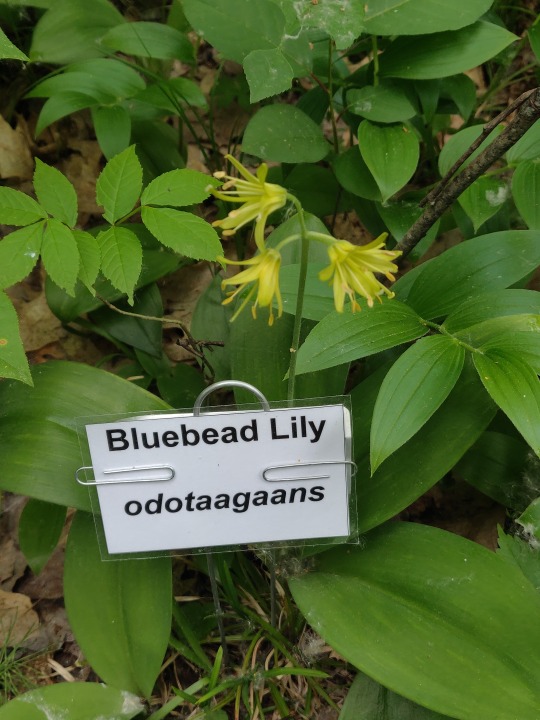



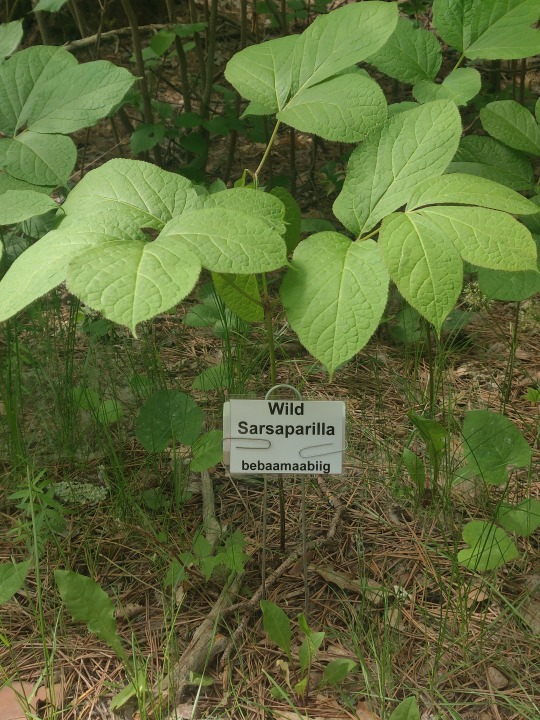
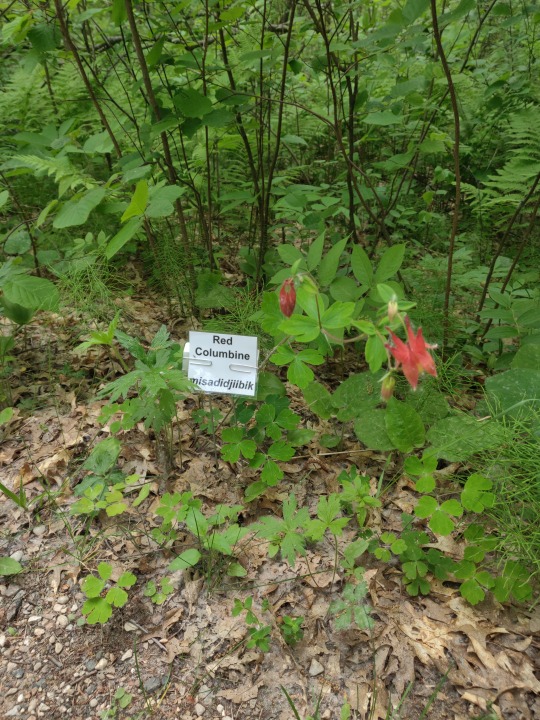
Bog plants, with their names in Ojibwe
#plants#bog#botany#nature#nature photography#photography#ojibwa#ojibwe#anishinaabe#minnesota#midwest#forest#flowers#wildflowers#mine#native american#land back
651 notes
·
View notes
Text

🐠 Pocket Anishinaabemowin (Ojibwe): A Phrasebook for Nearly All Occasions by Patricia M. Ningewance, C.M. (2009/2023)
A book on what to say in the Anishinaabe language at Airports, Bush Trails, Ceremonies, Conferences, Courtrooms, Emergencies, Hospitals, On the Phone, and While Visiting.
#godzilla reads#anishinaabe#anishinaabe language#Ojibwe language#book blog#book blurb#books and flowers#tbr#books#bookworm#reading#booklover
2 notes
·
View notes
Text


must make my minecraft world ojibwe
5 notes
·
View notes
Text
Geget sa naa niminwendaan epiichi-gimiwang gabe-dawateg, wii-nitaawiginoon iniw gitigaanan.
#I really love all the rain we got last week#the plants are gonna grow all nice#anishinaabe#anishinaabemowin#ojibwe#ojibwemowin#rain#flower#tiger lily#cinemetography#shot on iphone#plant#green#garden#flowers#raindrops
11 notes
·
View notes
Text
Strawberry Moon - June 21, 2024
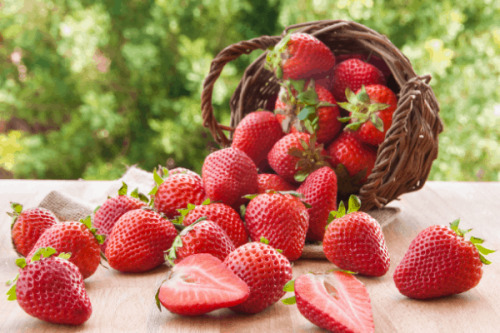
Grab your baskets and your moon jars, witches - it's time for the Strawberry Moon!
Strawberry Moon 🍓
The Strawberry Moon is the name given to the full moon which occurs in the month of June in the Northern Hemisphere. The name is taken from the ripening of those little red heart-shaped berries we find in so many summertime treats. Strawberries are typically ready to harvest beginning around the summer solstice, though this will vary depending on variety, planting times, and local weather. Sadly, the Strawberry Moon does not turn red or pink to match the berries.
Other European names for this moon include Honey Moon, Rose Moon, and Mead Moon. North American Indigenous names for the June moon include Blooming Moon (Anishinaabe), Green Corn Moon (Cherokee), and Hatching Moon (Cree).
This year's Strawberry Moon also roughly coincides with the summer solstice in the Northern Hemisphere, with peak illumination occurring at 9:08pm EST on June 21st. (The solstice is occurring one day prior, on June 20th.)
What Does It Mean For Witches? 🍓
Full moons are excellent times for bringing wishes to fulfillment and plans to fruition, all the more so under one named after a prolific berry. This is an optimal time to make things happen!
Your intuition may be stronger than usual during this time, so pay attention to those little inklings and gut feelings that won't be ignored. They might be telling you something important. Dreams may also be more vivid, though not necessarily more accurate or revealing.
This is a time to explore things that catch your attention or pique your curiosity, and to let yourself be open to new ideas and new opportunities.
What Witchy Things Can We Do? 🍓
With a full moon ripening in the sky and the summer solstice upon us, it's time to prepare for a full bloom. Here's hoping you've been nurturing those plans and seeds of growth you planted in the spring, because they're about to start flowering and the way is clear to sow the next stage of your plans. What they will be and what new prospects the summer will bring is entirely up to you.
The full moon is always a good time to look ahead to the future. Think on the plans you have in process and let yourself dream of how things might turn out. If you're inclined to journaling, make a note of how things are going so far and how you hope they'll turn out. Pick your favorite divination method and do a reading for the month ahead. (Make sure you write that down too so you can check back later!)
This is a great time to go berry-picking or flower-gathering, so check your area for pick-your-own farms or farmer's markets with local produce. Have a picnic with friends or just enjoy a quiet afternoon with your own thoughts and a few favorite treats. Make a jar of sun tea or a sweet and summery berry salad. If you're partial to strawberries, indulge that sweet tooth!
Strawberries are also excellent ingredient in spells for love, beauty, fertility, and emotional healing. Create a charm for self-love or perhaps to attract a summer romance. Enchant your favorite makeup or skin care products with a glamour of confidence. Just as expectant mothers once carried strawberry leaves as a folk remedy for pregnancy pains, you can carry a clutch of them in your pocket to help heal a broken heart or assuage the pain of grief. A packet of strawberry leaves is also a potent good-luck charm. Snack on strawberries to bring fertile abundance into your life, whether you're looking for creativity or opportunity or perhaps hoping to grow your family this year.
Charge your crystals and spell jars and moon water under the light of Strawberry Moon to catch the energy of blooming flowers, ripening fruit, wishes coming true, and carefully-laid plans realized. (If you're planning to use it for any consumables, please make sure you're using fresh, potable drinking water rather than rain or runoff.)
Spend a little time reflecting on how your year has gone thus far. Try to focus on the things that have improved and how you've grown as a person and in your life journey. Reflect on your accomplishments and what you plan to do next. Take a moment to be unashamedly proud of yourself for everything you've done and for making it this far despite everything life throws at you.
Happy Strawberry Moon, witches! 🌕🍓
Further Reading:
Bree's Lunar Calendar Series
Bree's Secular Celebrations Series
The Full Moon of June: A Special Solstice Full Moon, The Old Farmer's Almanac.
Strawberry Moon Meaning: The Spectacular Full Moon of June 2024, The Peculiar Brunette.
Everyday Moon Magic: Spells & Rituals for Abundant Living, Dorothy Morrison.
Image Source - Pesto and Margaritas
(If you're enjoying my content, please feel free to drop a little something in the tip jar or check out my published works on Amazon or in the Willow Wings Witch Shop. 😊)
#witchblr#witch community#lunar magic#full moon#strawberry moon#witchcraft#summer solstice#witch tips#moon magic#lunar calendar
393 notes
·
View notes
Link
0 notes
Text
Lunch by Chef Shawn Adler of Lac des Mille Lacs First Nation
For the inaugural post of this blog, I was very fortunate to have a delicious lunch provided with a dreamcatcher event at work as part of National Day for Truth and Reconciliation celebrations. It was a bit early this year, due to the timing of the official date (Sep 30) falling on a weekend.

The lunch consisted of:
A lovely, mixed greens salad in veggie ribbons, flowers and bean sprouts with an apple-honey vinaigrette
Jumbo Bison, smoked Ontario cheddar meatballs in a sage-cedar jus
Ontario corn succotash with squash and beans (3 sisters)
Wild rice pilaf with mushrooms, kale and pumpkin seeds
Sour cherry cornbread trifle
Wilds Soda Company Sodas in cedar and sweetgrass flavours
The wild rice pilaf was incredible, lots of depth and interesting flavours. The cornbread trifle was also wonderful, the flavour combination was not overly sweet and refreshing.
The chef is also the owner of owner of The Flying Chestnut Kitchen and Pow Wow Café. You can learn more about Anishinaabe chef Shawn Adler at CBC Gem. Follow Anishinaabe chef Shawn Adler into nature as he forages for unique wild foods that grow all around us. From wild ginger to burdock root, Shawn explores — and cooks with — hidden delights that can be found across Canada in each season of the year.
We also had the privilege to attend an interactive session led by William Morin, an educator and cultural consultant with Ojibway/Scottish/French Canadian heritage, introducing the Truth and Reconciliation Commission (TRC). Participants will sit in a circle, forming a dream catcher's hoop as it's woven. Morin will interweave teachings of the TRC, Medicine Wheel, Turtle Island, Moon Time, and their connections. With over 25 years of experience, he's taught Indigenous Studies and Anishinaabe Language Fundamentals at institutions such as the University of Sudbury, Laurentian University, McEwan School of Architecture, and Sudbury Catholic District School Board, enriching this unique experience. The session was powerful and memorable, and taught the importance of empathy, listening and creating healing of trauma.
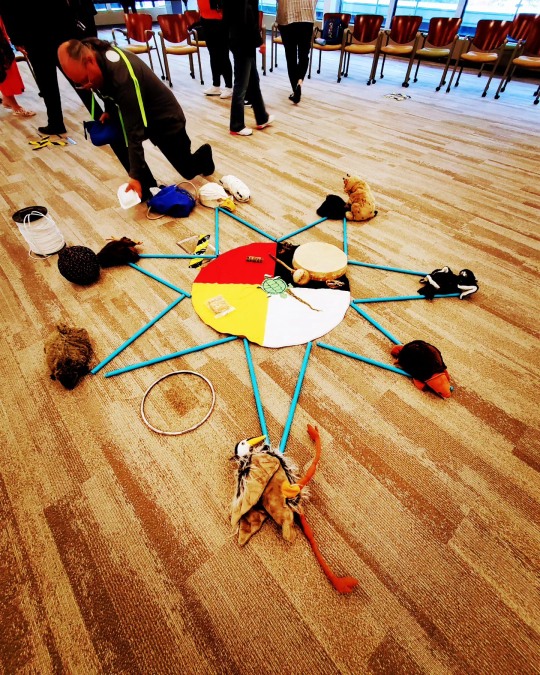
1 note
·
View note
Text




Alternative June Moon Names
Many cultures over time have used different names for the 12 full moons experienced each year. Usually, they’re not based on a color, but on a common activity that takes place that time of year.
Blooming Moon (Anishinaabe) is indicative of the flowering season, while Green Corn Moon (Cherokee) and Hoer Moon (Western Abenaki) suggest that it’s time to tend to young crops.
Other names highlight that this is a time of new life: The Tlingit have used the term Birth Moon, referring to the time when certain animals are born in their region (the Pacific Northwest). Egg Laying Moon and Hatching Moon are Cree terms that also hint at a time of many animal babies.
Alternative European names for this Moon include the Honey Moon and the Mead Moon. June was traditionally the month of marriage, and is even named after the Roman goddess of marriage, Juno. Following marriage comes the “honeymoon,” which may be tied to this alternative Moon name!
Native American Algonquin tribes named this Moon the Strawberry Moon. This is because they would harvest strawberries during this time.
-midnight-🖤🩶
1 note
·
View note
Text

I couldn't decide what to draw so I just filled a page with waabigwaniin
218 notes
·
View notes
Text

IG @ARTBY_HZ
4 notes
·
View notes
Text
In honor of Native American Heritage Month, and due to the requests I've received over the years, I've compiled a list of great books written by indigenous authors from all over the Americas.
Part 1, North America:
Fantasy/Sci-Fi/Magical Realism/Mythology/Dystopia: “Elatsoe” by Darcie Little Badger (Lipan Apache) “Moon of the Crusted Snow” by Waubgeshig Rice (Anishinaabe) "The Marrow Thieves" by Cherie Dimaline (Georgian Bay Métis) "Son of a Trickster" by Eden Robinson (Haisla and Heiltsuk) “The Removed” by Brandon Hobson (Cherokee)
Nonfiction/Memoir/Essays: “Braiding Sweetgrass: Indigenous Wisdom, Scientific Knowledge, and the Teachings of Plants” by Robin Wall Kimmerer (Potawatomi) "A History of My Brief Body" by Billy-Ray Belcourt (Driftpile Cree) “A Mind Spread Out on the Ground” by Alicia Elliott (Haudenosaunee) "An American Sunrise" by Joy Harjo (Muscogee) “Dog Flowers: A Memoir” by Danielle Geller "Seven Fallen Feathers: Racism, Death, and Hard Truths in a Northern City" by Tanya Talaga (Anishinaabe) "The Red Deal: Indigenous Action to Save Our Earth" by The Red Nation “Heart Berries” by Terese Marie Mailhot (Nlaka'pamux)
Contemporary/Fiction/Historical Fiction: “Indian Horse” and “Medicine Walk” by Richard Wagamese (Ojibwe) “Jonny Appleseed” by Joshua Whitehead (Oji-Cree, Peguis First Nation) “There There” by Tommy Orange (Cheyanne and Arapho) “The Break” by Katherena Vermette (Red River Métis) “Five Little Indians” by Michelle Good (Red Pheasant Cree Nation) “The Seed Keeper” by Diane Wilson (Mdewakanton Oyate, Rosebud Sioux) “Birdie” by Tracey Lindberg (Cree-Métis, As'in'i'wa'chi Ni'yaw Nation Rocky Mountain Cree)
Mystery/Thriller/Horror/Paranormal: “The Only Good Indians” by Stephen Graham Jones (Blackfeet) “Winter Counts” by David Heska Wanbli Weiden (Sicangu Lakota) “Firekeeper’s Daughter” by Angeline Boulley (Chippewa) "Empire of Wild" by Cherie Dimaline (Georgian Bay Métis Nation)
Poetry Collections: "Islands of Decolonial Love: Stories and Songs" and "This Accident of Being Lost: Songs and Stories" by Leanne Betasamosake Simpson (Mississauga Nishnaabeg) "Split Tooth" by Tanya Tagaq (Inuk) “Postcolonial Love Poem” by Natalie Díaz (Akimel O'odham) "Nature Poem" by Tommy Pico (Kumeyaay, Viejas Group of Capitan Grande Band of Mission Indians) "Disintegrate/Dissociate" by Arielle Twist (Cree, George Gordon First Nation)
Anthologies: “Love After the End: An Anthology of Two-Spirit and Indigiqueer Speculative Fiction”, contributed to by Joshua Whitehead, David Alexander Robertson, Darcie Little Badger, Nathan Adler, Gwen Benaway, Nazbah Tom, Gabriel Castilloux Calderón, and Kai Minosh Pyle "This Place: 150 Years Retold" (comic, nonfiction), contributed to by Kateri Akiwenzie-Damm, Chelsea Vowel, Katherena Vermette, Jen Storm, Niigaanwewidam James Sinclair, David Alexander Robertson, Richard Van Camp, Brandon Mitchell, Sonny Assu, Rachel Qitsualik-Tinsley, Sean Qitsualik-Tinsley, Alicia Elliott, and illustrated by G.M.B. Chomichuk, Scott B. Henderson, Tara Audibert, Natasha Donovan, Kyle Charles, Scott A. Ford, Donovan Yaciuk, Andrew Lodwick, Ryan Howe “Moonshot: The Indigenous Comics Collection, Volume 1”, contributed to by Hope Nicholson, Michael Sheyahshe, David W. Mack, David Alexander Robertson, Haiwei Hou, Dayton Edmonds, Micah Farritor, Sean Qitsualik-Tinsley, Rachel Qitsualik-Tinsley, Menton3, Arigon Starr, David Cutler, Elizabeth LaPensée, G.M.B. Chomichuk, George Freeman, Tony Romito, Jeremy D. Mohler, Ian Ross, Lovern Kindzierski, Adam Gorham, Richard Van Camp, Nicholas Burns, Todd Houseman, Ben Shannon, Jay Odjick, Joel Odjick, Claude St. Aubin, Buffy Sainte-Marie, Andy Stanleigh
More: New books that I haven't read/heard enough about to recommend yet
Part 2: Central & South America
472 notes
·
View notes
Photo








sometimes i wish i spoke no English at all. on Indigenous anger and languages:
"red language" heid e. erdrich // “devils language” marilyn dumont // the chase kent monkman // “the disconnection” clark douglas // braiding sweetgrass robin wall kimmerer // "the word for gossip" eric gansworth // honouring my spirit helpers christi belcourt // “dear new blood” mark turcotte
image description:
image 1: an excerpt from the poem “red language” by Ojibwe poet heid e. erdrich, reading: “offer my own red language / my tongue to your tongue / so we recall what we once said / that made us live.”
image 2: an excerpt from the poem “devils language” by Métis poet marilyn dumont, reading “the Great White way could silence us all / if we let it / its had its hand over my mouth since my first day of school / since Dick and Jane, ABC's and fingernail checks / syntactic laws: use the wrong order or / register and you're a dumb Indian / dumb, drunk or violent”
image 3: a painting by Cree artist kent monkman, where bison in different styles of painting run down a city street. A Native man with bow and arrow hunts them, riding his motorcycle like a horse.
image 4: an excerpt from the poem “the disconnection,” by me, reading: “if I say it enough,/ will they remember these words too? /will the muscle memory of cree come back into us, shift our tongues just right, / will the fog of being colonized fade, will it be gone / just like that?”
image 5: a quote from the book braiding sweetgrass by citizen potawatomi writer, robin wall kimmerer, reading “In some Native languages the term for plant translates to ‘those who take care of us.’”
image 5: an excerpt from the poem “the word for gossip” by Haudenosaunee poet eric gansworth, reading: “In English, you want to say “I heard” / and not “They say,” and if you don’t / understand the importance of that / difference, it is good that we travel / our parallel paths, crossing only in / the wake we leave to dissipate behind us.”
image 6: a painting by Métis artist Christi Belcourt, in the floral style of traditional Métis beadwork. everything is connected, from flowers to roots to animals.
image 7: an excerpt from the poem “dear new blood” by Anishinaabe poet mark turcotte, reading: “Mourn. I think you, / too, were born with broken heart. / Rise. Smash your un-American throat / against the edge of the sky.”
#web weaving#webweaving#parallels#ndn#yes i included an excerpt from my own poetry what about it#indigenous#mine
274 notes
·
View notes
Photo
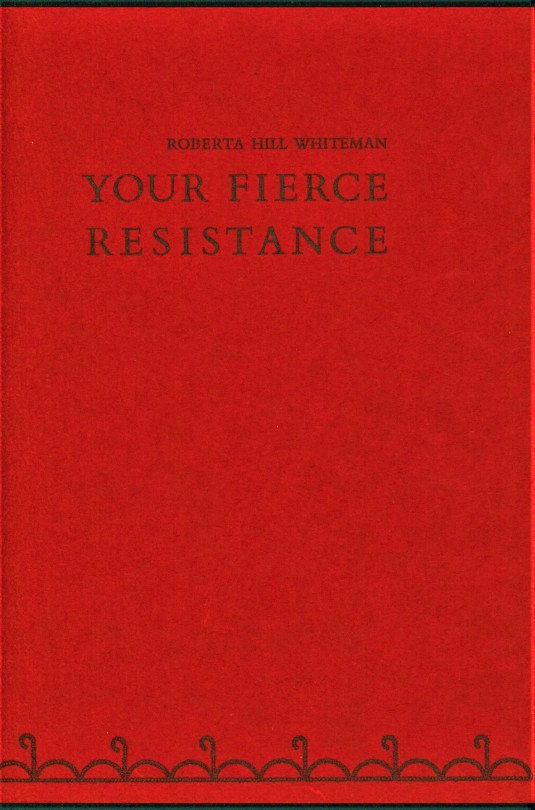

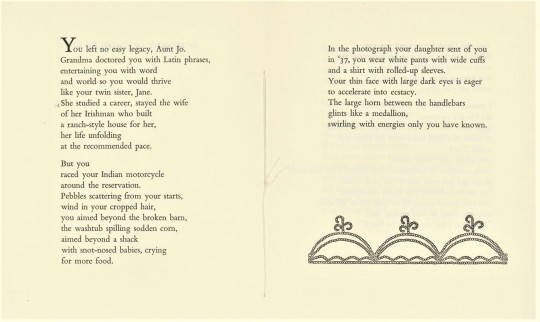

First Nations Fine Press Friday
Roberta Hill
In association with our post this week on Roberta Hill, we present the fine press printing of an excerpt from Hill’s 1993 poem, Your Fierce Resistance. Printed in an edition of 150 copies at the Minnesota Center For Book Arts (MCBA) in conjunction with literary center The Loft for the Inroads: Writers of Color series,Your Fierce Resistance is an excerpt of a longer poem of the same title. The full-length poem can be found in Roberta J. Hill’s (then, Roberta Hill Whiteman) second poetry book collection, Philadelphia Flowers: Poems, published by the Holy Cow! Press in 1996. The edition was was printed by Robert Johnson of the Melia Press and wood engraver, printer, designer, poet, and illustrator Gaylord Schanilec using Bembo type on Mohawk Superfine paper, with Fabriano Italia endsheets and Moriki Over Arches covers, supported in part by a grant from the National Endowment for the Arts.
Hill completed her PhD with a biographical study of her paternal grandmother, Dr. Lillie Rosa Minoka-Hill—the second American Indian woman to earn an M.D. in the United States. Minoka was of Mohawk descent, but had moved with her husband to the Wisconsin Oneida Reservation where she opened a “kitchen clinic” to serve the Oneida peoples. She’s said to have been adopted by the Oneida Nation of Wisconsin—the only person in the 20th century to be officially adopted by them—and was given the name Yo-da-gent, meaning “she who saves” or “she who carries help”.
The book, however is dedicated to another family member, Josephine Coté, Hull’s matrilineal aunt. Nonconformity must run in the women of this family, as Hill’s writing honors her aunt’s outward resistance to all pressures of assimilatory expectations, both inside and outside the Oneida reservation. Hill recalls a conversation with Coté, in Your Fierce Resistance,
Then you asked me, “What passes from a mother to her child?” You shifted your thin body closer and put your elbows on your knees. “Its mother’s blood. The blood remembers,” you said, straightening up to look me in the eyes, snapping them in your teasing way. “Whatever’s lost can often be found.”
Roberta Hill’s three poetry collections revolve around the communal feeling of disconnection within the Oneida Nation’s people, where she utilizes nature-centric Native American/First Nations ideals to take a firm stance against the capitalistic consumption polluting our environment. Hill has read her poems throughout the United States and at International Poetry Festivals in Medellin, Columbia and Poesia Do Mundo in Coimbra, Portugal, as well as in China, Australia, and New Zealand. Hill has retired from her position as a Professor of English and American Indian Studies, affiliated with the Nelson Institute for Environmental Studies, in May of 2020, and now lives in the Driftless area of Wisconsin.
View more Fine Press Friday posts.
–Isabelle, Special Collections Undergraduate Writing Intern
We acknowledge that in Milwaukee we live and work on traditional Potawatomi, Ho-Chunk, and Menominee homelands along the southwest shores of Michigami, part of North America’s largest system of freshwater lakes, where the Milwaukee, Menominee, and Kinnickinnic rivers meet and the people of Wisconsin’s sovereign Anishinaabe, Ho-Chunk, Menominee, Oneida, and Mohican nations remain present.
#Fine Press Friday#Fine Press Fridays#Fine Press#Your Fierce Resistance#Roberta Hill#Josephine Cote#Lillie Rosa Minoka-Hill#Robert Johnson#Gaylord Schanilec#Minnesota Center for Book Arts#The Loft#Inroads#Writers of Color series#Mohawk#Philadelphia Flowers#Oneida Nation of Wisconsin#Native American Poets#Indigenous Writers#Bembo#Fabriano#Moriki Over Arches#National Endowment for the Arts#Limited Edition#Isabelle
25 notes
·
View notes
Text
On a different note, I've been working to make myself more familiar with local wildlife, learning how to identify plants and recognize birdcalls and put names to things that used to just be vague flowers and animals.
And it's been nice but it's also painful because while I'm learning the English and Latin names for them, I'm also realizing how few resources there are for learning their Anishinaabemowin names. There's quite a few in different Anishinaabe dictionaries floating around online but there's also so many that are missing, and I KNOW that my ancestors must've had names for them and that there's probably people who still know those names, I just. Can't find them.
I don't know where I'm going with this. It just hurts sometimes.
73 notes
·
View notes
Text
Buck Moon - July 20-21, 2024
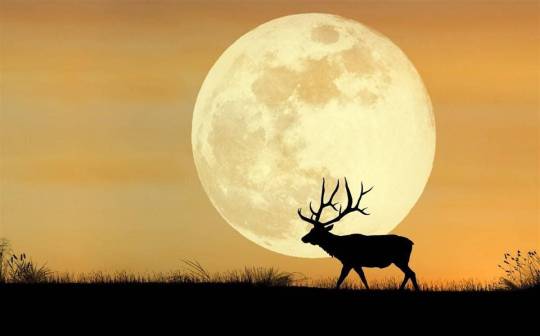
Put on your flower crowns and your walking shoes - it’s time for the Buck Moon!
Buck Moon 🦌
The Buck Moon is the name given to the full moon in the month of July and is called this because at this time of year, the rack of antlers previously shed by male deer are beginning to regrow and harden in preparation for the fall rutting season.
Other North American Indigenous names for this moon include Salmon Moon (Tlingit), Berry Moon (Anishinaabe), Month of the Ripe Corn Moon (Cherokee), and Raspberry Moon (Algonquin, Ojibwe). The West Abenaki also call this the Thunder Moon in reference to the often-stormy summer weather. (This one is my personal favorite and the name appears in lunar calendars just as often as the Buck Moon.)
European names for the July moon include Hay Moon and Wort Moon, and it should be noted that the name Stag Moon does appear in some European sources as well.
This year's Buck Moon will be at peak illumination at 6:17am EST on July 21st, so the moon will appear to be full on both the 20th and 21st. Also, it's a weekend, so plan your festivities accordingly!
What Does It Mean For Witches? 🦌
The July full moon continues June’s template of planning for the future, this time with a focus on your passions and ambitions. Reflect on what you’ve accomplished so far this year and plan your next step.
Dream big and plan big, but don’t give in to reckless urgency. Summer (and capitalist grind culture) gives us the urge to Go Go Go. Despite all this, it’s important to take time to rest and recharge, lest we find ourselves burning out and losing our motivation.
What Witchy Things Can We Do? 🦌
Celebrate your victories and revel in the abundance of the summer season. If you’re inclined to do so, take a page from the deer and do a bit of prancing around a bonfire or your favorite flower arbor with some festive flowery headgear.
Go exploring! Find a local park or garden and take a stroll among the greenery, or use TV and the internet to explore and learn about faraway places. This is another opportune time to go and check out pick-your-own farms and farmers markets as well. Sharpen your foraging and plant identification skills while you’re out and about!
If you’re tending a garden, harvest some herbs and investigate what you can make with them. Whether it’s seasoning for meals, homemade botanical products, or just helpful spell ingredients, many herbs and flowers have a plethora of uses. As an exercise, select three plants growing in your yard or garden, research their magical correspondences and botanical properties, and try to think of as many ways as possible to use each one for witchcraft and for practical purposes. For extra credit, pick something native to your area that doesn't appear in the western magical canon and use its' physical, folkloric, and historical associations to create something new!
(Safety Note: Always clean and prepare home-harvested herbs properly before using them for kitchen, bath, or medical preparations. Always be sure to properly identify any wildcrafted or foraged plants. Always consult a doctor before trying an herbal treatment and take all allergies, medications, and pre-existing conditions into account. Please also note that while herbal treatments can be helpful, it can have negative interactions and side effects just like any other medication, and it is not meant to be a replacement for modern medical care.)
Apart from the usual full-moon festivities, I’ve always found this is an excellent time for weather-witching. Summer weather is notoriously fickle, but it is also highly malleable - one recalls that old American Southern epithet of, “If you don’t like the weather, wait five minutes.”
If you’re hoping to bring some rain to water your garden or break the back of a heat wave, this may be the time to do it. My personal favorite folk magic ritual for rain-calling involves going outside with a broom and a bucket of water, using the broom to scatter drops of water over your yard, and shouting up to the clouds, “SEE? IT’S NOT HARD!”
Make sure you take local weather patterns into account and try to draw on existing fronts and nearby precipitation to get the desired result. And keep in mind that with weather magic, less is more and one casting is enough. Asking for too much or asking too often can produce undesirable results. And if you manage to make it rain, be sure to collect some for moon water!
If you’re interested in weather-witching, I highly recommend checking out this masterpost by @stormbornwitch for a number of excellent articles and suggestions.
Happy Buck Moon, witches! 🌕🦌
Sources and Further Reading:
Bree’s Lunar Calendar Series
Bree’s Secular Celebrations Series
Witchcraft Exercise - Creating Correspondences
Buck Moon: Full Moon in July 2024, The Old Farmer's Almanac.
Buck Moon Bonanza: Embrace July’s Massive Energy!, The Peculiar Brunette.
Everyday Moon Magic: Spells & Rituals for Abundant Living, Dorothy Morrison.
(If you’re enjoying my content, please feel free to drop a little something in the tip jar or check out my published works on Amazon or in the Willow Wings Witch Shop. 😊)
#witchblr#witch community#witchcraft#full moon#moon magic#pagan#buck moon#thunder moon#lunar magic#lunar calendar
211 notes
·
View notes